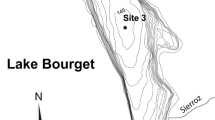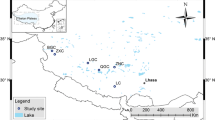Abstract
The differences in methanogen abundance and community composition were investigated between nearshore and offshore sediments in the South Yellow Sea (SYS). Shannon, Simpson, and Chao1 indices revealed a higher diversity of methanogens in the nearshore sediments than in the offshore sediments. The Mann—Whitney U test demonstrated that the relative abundance of Methanococcoides was significantly higher in the offshore sediments, while the relative abundances of Methanogenium, Methanosarcina, Methanosaeta, Methanolinea, and Methanomassiliicoccus were significantly higher in the nearshore sediments (P < 0.05). The abundance of the mcrA gene in the nearshore sediments was significantly higher than that in the offshore sediments. Furthermore, a similar vertical distribution of the methanogen and sulfate-reducing bacteria (SRB) abundances was observed in the SYS sediments, implying there is potential cooperation between these two functional microbes in this environment. Finally, total organic carbon (TOC) was significantly correlated with methanogen community composition.
Similar content being viewed by others
References
Bakker, D.C.E., Bange, H.W., Gruber, N., Johannessen, T., Upstill-Goddard, R.C., Borges, A.V., Delille, B., Löscher, C.R., Naqvi, S.W.A., Omar, A.M., et al. 2014. Air-sea interactions of natural long-lived greenhouse gases (CO2, N2O, CH4) in a Changing Climate. In Liss, P.S. and Johnson, M.T. (eds.), Advances in Geomorphology and Quaternary Studies in Argentina, pp. 113–169. Springer, Berlin, Heidelberg, Germany.
Bange, H.W., Bartell, U.H., Rapsomanikis, S., and Andreae, M.O. 1994. Methane in the Baltic and North Seas and a reassessment of the marine emissions of methane. Global Biogeochem. Cycles 8, 465–480.
Bokulich, N.A., Subramanian, S., Faith, J.J., Gevers, D., Gordon, J.I., Knight, R., Mills, D.A., and Caporaso, J.G. 2013. Quality-filtering vastly improves diversity estimates from Illumina amplicon sequencing. Nat. Methods 10, 57–59.
Chen, Y., Li, S., Xu, X., Ma, M., Mi, T., Zhen, Y., and Yu, Z. 2020. Characterization of microbial communities in sediments of the South Yellow Sea. J. Ocean. Limnol. 39, 846–864.
Conrad, R. 2007. Microbial ecology of methanogens and methanotrophs. In Sparks, D.L. (ed.) Advances in Agronomy, vol. 96, pp. 1–63. Academic Press, San Diego, California, USA.
Edgar, R.C., Haas, B.J., Clemente, J.C., Quince, C., and Knight, R. 2011. UCHIME improves sensitivity and speed of chimera detection. Bioinformatics 27, 2194–2200.
Ferry, J.G. 1993. Methanogenesis: Ecology, Physiology, Biochemistry & Genetics. Chapman & Hall Microbiology Series. Springer, Boston, Massachusetts, USA.
Finke, N., Hoehler, T.M., and Jørgensen, B.B. 2007. Hydrogen ‘leakage’ during methanogenesis from methanol and methylamine: implications for anaerobic carbon degradation pathways in aquatic sediments. Environ. Microbiol. 9, 1060–1071.
Geets, J., Borremans, B., Diels, L., Springael, D., Vangronsveld, J., van der Lelie, D., and Vanbroekhoven, K. 2006. DsrB gene-based DGGE for community and diversity surveys of sulfate-reducing bacteria. J. Microbiol. Methods 66, 194–205.
He, C.P., Wang, Y.X., Lei, Z.Y., and Xu, S. 1959. A preliminary study of the formation of Yellow Sea Cold Water Mass and its properties. Oceanol. Limnol. Sin. 2, 11–15.
Holmer, M. and Kristensen, E. 1994. Coexistence of sulfate reduction and methane production in an organic-rich sediment. Mar. Ecol. Prog. Ser. 107, 177–184.
Hu, L., Shi, X., Guo, Z., Wang, H., and Yang, Z. 2013. Sources, dispersal and preservation of sedimentary organic matter in the Yellow Sea: the importance of depositional hydrodynamic forcing. Mar. Geol. 335, 52–63.
Intergovernmental Panel on Climate Change, IPCC. 2015. Climate Change 2014: Mitigation of Climate Change: Working Group III to the Fifth Assessment Report. Cambridge University Press, Cambridge, United Kingdom.
Jørgensen, B.B. 2006. Bacteria and marine biogeochemistry. In Schulz, H.D. and Zabel, M. (eds.), Marine Geochemistry, 2nd edn, pp. 169–206. Springer, Berlin, Heidelberg, Germany.
Kendall, M.M., Wardlaw, G.D., Tang, C.F., Bonin, A.S., Liu, Y., and Valentine, D.L. 2007. Diversity of Archaea in marine sediments from Skan Bay, Alaska, including cultivated methanogens, and description of Methanogenium boonei sp. nov. Appl. Environ. Microbiol. 73, 407–414.
Knittel, K. and Boetius, A. 2009. Anaerobic oxidation of methane: progress with an unknown process. Annu. Rev. Microbiol. 63, 311–334.
L’Haridon, S., Chalopin, M., Colombo, D., and Toffin, L. 2014. Methanococcoides vulcani sp. nov., a marine methylotrophic methanogen that uses betaine, choline and N,N-dimethylethanolamine for methanogenesis, isolated from a mud volcano, and emended description of the genus Methanococcoides. Int. J. Syst. Evol. Microbiol. 64, 1978–1983.
Lazar, C.S., Parkes, R.J., Cragg, B.A., L’Haridon, S., and Toffin, L. 2011. Methanogenic diversity and activity in hypersaline sediments of the centre of the Napoli mud volcano, Eastern Mediterranean Sea. Environ. Microbiol. 13, 2078–2091.
Li, Q., Wang, F., Chen, Z., Yin, X., and Xiao, X. 2012. Stratified active archaeal communities in the sediments of Jiulong River Estuary, China. Front. Microbiol. 3, 311.
Li, H., Xiao, T., Ding, T., and Lü, R. 2006. The distribution of bacterioplankton in the Yellow Sea Cold Water Mass (YSCWM). Acta Ecol. Sin. 26, 1012–1019.
Li, H., Yang, Q., and Zhou, H. 2020. Niche differentiation of sulfate- and iron-dependent anaerobic methane oxidation and methylotrophic methanogenesis in deep sea methane seeps. Front. Microbiol. 11, 1409.
Liu, Y. and Whitman, W. 2008. Metabolic, phylogenetic, and ecological diversity of the methanogenic archaea. Ann. N.Y. Acad. Sci. 1125, 171–189.
Lyimo, T.J., Pol, A., Jetten, M.S., and den Camp, H.J. 2009. Diversity of methanogenic archaea in a mangrove sediment and isolation of a new Methanococcoides strain. FEMS Microbiol. Lett. 291, 247–253.
Ma, T.T., Liu, L.Y., Rui, J.P., Yuan, Q., Feng, D., Zhou, Z., Dai, L.R., Zeng, W.Q., Zhang, H., and Cheng, L. 2017. Coexistence and competition of sulfate-reducing and methanogenic populations in an anaerobic hexadecane-degrading culture. Biotechnol. Biofuels 10, 207.
Magoč, T. and Salzberg, S.L. 2011. FLASH: fast length adjustment of short reads to improve genome assemblies. Bioinformatics 27, 2957–2963.
Maltby, J., Sommer, S., Dale, A.W., and Treude, T. 2016. Microbial methanogenesis in the sulfate-reducing zone of surface sediments traversing the Peruvian margin. Biogeosciences 13, 283–299.
Maltby, J., Steinle, L., Löscher, C., Bange, H., Fischer, M., Schmidt, M., and Treude, T. 2018. Microbial methanogenesis in the sulfate-reducing zone of sediments in the Eckernförde Bay, SW Baltic Sea. Biogeosciences 15, 137–157.
Niu, M., Fan, X., Zhuang, G., Liang, Q., and Wang, F. 2017. Methane-metabolizing microbial communities in sediments of the Haima cold seep area, northwest slope of the South China Sea. FEMS Microbiol. Ecol. 93, fix101.
Oremland, R.S. and Polcin, S. 1982. Methanogenesis and sulfate reduction: competitive and noncompetitive substrates in estuarine sediments. Appl. Environ. Microbiol. 44, 1270–1276.
Ozuolmez, D., Na, H., Lever, M.A., Kjeldsen, K.U., Jørgensen, B.B., and Plugge, C.M. 2015. Methanogenic archaea and sulfate reducing bacteria co-cultured on acetate: teamwork or coexistence? Front. Microbiol. 6, 492.
Reeburgh, W. 2007. Oceanic methane biogeochemistry. Chem. Rev. 107, 486–513.
Rooney-Varga, J., Giewat, M., Duddleston, K., Chanton, J., and Hines, M. 2007. Links between archaeal community structure, vegetation type and methanogenic pathway in Alaskan peatlands. FEMS Microbiol. Ecol. 60, 240–251.
Smith, K.S. and Ingram-Smith, C. 2007. Methanosaeta, the forgotten methanogen? Trends Microbiol. 15, 150–155.
Steinberg, L. and Regan, J. 2008. Phylogenetic comparison of the methanogenic communities from an acidic, oligotrophic fen and an anaerobic digester treating municipal wastewater sludge. Appl. Environ. Microbiol. 74, 6663–6671.
Su, J. and Huang, D. 1995. On the current field associated with the Yellow Sea Cold Water Mass. Oceanol. Limnol. Sin 26, 1–7.
Tamura, K., Peterson, D., Peterson, N., Stecher, G., Nei, M., and Kumar, S. 2011. MEGA5: molecular evolutionary genetics analysis using maximum likelihood, evolutionary distance, and maximum parsimony methods. Mol. Biol. Evol. 28, 2731–2739.
Treude, T., Smith, C., Wenzhöefer, F., Carney, E., Bernardino, A., Hannides, A., Krüger, M., and Boetius, A. 2009. Biogeochemistry of a deep-sea whale fall: sulfate reduction, sulfide efflux and methanogenesis. Mar. Ecol. Prog. Ser. 382, 1–21.
Vigneron, A., L’Haridon, S., Godfroy, A., Roussel, E., Cragg, B., Parkes, R., and Toffin, L. 2015. Evidence of active methanogen communities in shallow sediments of the Sonora Margin cold seeps. Appl. Environ. Microbiol. 81, 3451–3459.
Visser, A., Beeksma, I., van der Zee, F., Stams, A., and Lettinga, G. 1993. Anaerobic degradation of volatile fatty acids at different sulfate concentration. Appl. Microbiol. Biotechnol. 40, 549–556.
Wang, Y., Hu, X., Sun, Y., and Wang, C. 2021. Influence of the cold bottom water on taxonomic and functional composition and complexity of microbial communities in the southern Yellow Sea during the summer. Sci. Total Environ. 759, 143496.
Wang, B., Liu, F., Zheng, S., and Hao, Q. 2019. Trophic strategy of diverse methanogens across a river-to-sea gradient. J. Microbiol. 57, 470–478.
Watkins, A.J., Roussel, E.G., Parkes, R.J., and Sass, H. 2014. Glycine betaine as a direct substrate for methanogens (Methanococcoides spp.). Appl. Environ. Microbiol. 80, 289–293.
Wen, X., Yang, S., Horn, F., Winkel, M., Wagner, D., and Liebner, S. 2017. Global biogeographic analysis of methanogenic archaea identifies community-shaping environmental factors of natural environments. Front. Microbiol. 8, 1339.
Whiticar, M. 1999. Carbon and hydrogen isotope systematics of bacterial formation and oxidation of methane. Chem. Geol. 161, 291–314.
Xiao, K.Q., Beulig, F., Kjeldsen, K.U., Jørgensen, B.B., and Risgaard-Petersen, N. 2017. Concurrent methane production and oxidation in surface sediment from Aarhus Bay, Denmark. Front. Microbiol. 8, 1198.
Xiao, K.Q., Beulig, F., Røy, H., Jørgensen, B.B., and Risgaard-Petersen, N. 2018. Methylotrophic methanogenesis fuels cryptic methane cycling in marine surface sediment. Limnol. Oceanogr. 63, 1519–1527.
Yao, P., Zhao, B., Bianchi, T., Guo, Z., Zhao, M., Li, D., Pan, H., Wang, J., Zhang, T., and Yu, Z. 2014. Remineralization of sedimentary organic carbon in mud deposits of the Changjiang Estuary and adjacent shelf: implications for carbon preservation and authigenic mineral formation. Cont. Shelf Res. 91, 1–11.
Zhang, G., Zhang, J., Kang, Y., and Liu, S. 2004. Distributions and fluxes of methane in the East China Sea and the Yellow Sea in Spring. J. Geophys. Res. Oceans 109, C07011.
Zhuang, G.C., Elling, F.J., Nigro, L.M., Samarkin, V., Joye, S., Teske, A., and Hinrichs, K.U. 2016. Multiple evidence for methylotrophic methanogenesis as the dominant methanogenic pathway in hypersaline sediments from the Orca Basin, Gulf of Mexico. Geochim. Cosmochim. Acta 187, 1–20.
Zhuang, G.C., Heuer, V.B., Lazar, C.S., Goldhammer, T., Wendt, J., Samarkin, V.A., Elvert, M., Teske, A.P., Joye, S.B., and Hinrichs, K.U. 2018a. Relative importance of methylotrophic methanogenesis in sediments of the Western Mediterranean Sea. Geochim. Cosmochim. Acta 224, 171–186.
Zhuang, G.C., Montgomery, A., Sibert, R.J., Rogener, M.K., Samarkin, V.A., and Joye, S.B. 2018b. Effects of pressure, methane concentration, sulfate reduction activity, and temperature on methane production in surface sediments of the Gulf of Mexico. Limnol. Oceanogr. 63, 2080–2092.
Acknowledgements
We thank all of the scientists and crew members on the R/V Ke Xue San Hao for the assistance provided in the collection of samples during the cruise. This work was supported by the National Natural Science Foundation of China (No. 41806131 and 42106137), the Shandong Provincial Natural Science Foundation, China (No. ZR2019QG00) and the Marine S&T Fund of Shandong Province for Pilot National Laboratory for Marine Science and Technology(Qingdao) (No. 2021QNLM020002).
Author information
Authors and Affiliations
Corresponding author
Ethics declarations
The authors have no conflict of interest to report.
Electronic supplementary material
Rights and permissions
About this article
Cite this article
Chen, Y., Zhen, Y., Wan, J. et al. Differences in the methanogen community between the nearshore and offshore sediments of the South Yellow Sea. J Microbiol. 60, 814–822 (2022). https://doi.org/10.1007/s12275-022-2022-2
Received:
Revised:
Accepted:
Published:
Issue Date:
DOI: https://doi.org/10.1007/s12275-022-2022-2




